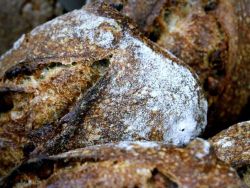
What Is The Glycemic Index Of Sourdough Bread?

Many people prefer sourdough bread over regular white bread because they believe that it’s healthier. This belief, along with its gorgeous flavour has led to sourdough bread becoming increasingly popular. But, does the long fermentation process of making sourdough actually lower its Glycemic Index? Let’s find out!
Sourdough bread has a Glycemic Index of 54 which is much lower than regular white bread, at around 72-90. The reason sourdough bread is low GI is its long fermentation process which lowers its starch content. Sourdough can be considered in a low GI diet and is great at controlling blood sugar levels.
What is the glycemic index?
The glycemic index (GI) is a scale used to measure how a food raises blood sugar levels. It helps sugar-sensitive individuals watch and manage what they’re eating. This includes diabetics and those watching their sugar levels
Food ranks on a scale of 1-100. The lower the number, the better for individuals.
Common High GI Foods
High GI foods are ranked at 70 or greater. This group of food includes:
- White rice and white bread
- Breakfast cereals and cereal bars
- Cakes, cookies, and sweet treats
- Chips, and crackers
- Watermelon
Medium GI Foods
Medium GI foods are ranked at 56-69. Usually, these are:
- Basmati rice
- Whole wheat bread and rye bread
- Sweet corn and mangoes
- Bran cereal and pasta made with whole grains
- Ice cream
Low GI foods
Low GI foods are ranked at 55 or lower. Usually, these are:
- Milk
- Butter beans and peas
- Barley and oats
- Whole grain sourdough bread
What does this GI mean for diabetics?
If you have been diagnosed with diabetes then the impact of high GI foods is important. With the GI index, you can select food that suits your needs and avoid those that don’t. Eating low Gi foods regularly will prevent:
- Poor circulation to the eyes and feet
- Problems with nerve function (experienced as numbness)
- Kidney damage and risk of kidney failure
- In some cases, an increase in the risk for heart disease.
With the help of GI, diabetics can plan ahead. Regularly consuming low GI foods improves the body’s response to insulin and decreases the risk of type 2 diabetes
Is sourdough bread better for a low GI diet?
Yes! Sourdough bread is great for people who are on a low GI diet! Sourdough bread usually has a GI rating of 54. This compares to a GI rating of 71 for a typical bread that’s made from white wheat flour. Sourdough bread also contains fewer carbohydrates.
Why does sourdough lower the glycemic index?
A sourdough goes through a lengthy fermentation process. Here the starch is broken down into sugars which then get used by the yeast and organic acids. The organic acids in sourdough also delay the absorption of sugars into the body.
There are 2 main types of organic acid produced in the fermentation process of sourdough.
Lactic acid slows the absorption of starch and sugars in our bodies.
Acetic acid delays the gastric emptying rate. This is the speed at which substances leave the stomach after ingestion.
Will sourdough help to manage blood sugar?
Researchers haven’t entirely found out why sourdough bread has a better effect on blood sugar and insulin levels than other types of bread. It’s believed that sourdough particles are able to modify the carb molecules of a dough somehow. This results in the reduction of the bread’s GI.
Of course, eating sourdough bread will be less likely to make your blood sugar levels rise than commercial bread. It also produces fewer phytates which are the antibodies that bind to minerals and prevent them from being absorbed in our body.
Should I eat sourdough bread if I eat a low GI diet?
Definitely! Sourdough bread is great for people who eat a low GI diet. Sourdough bread has a lower GI than the usual white bread, it’s also a great source of fibre, B vitamins, and minerals. If you’re diagnosed with diabetes or you’re just trying to reduce the risk, it’s best to have sourdough bread instead of standard sliced white bread.
Final thoughts
The Glycemic Index is designed for individuals that are concerned about their blood sugar levels. Low GI foods are recommended as part of a healthy diet and exercise program. Compared to other types of bread, the glycemic index of sourdough bread leads to healthier blood sugar levels. It also contains significantly lower phytate levels and provides other natural vitamins and minerals. But of course, to maintain healthy blood sugar levels, you still have to watch the amount of bread that’s eaten. It’s still packed full of carbs! Sourdough bread is not a miracle cure for diabetes or high blood sugar levels. It just helps lead the way towards a healthier life.
If you’ve enjoyed this article and wish to treat me to a coffee, you can by following the link below – Thanks x

Hi, I’m Gareth Busby, a baking coach, senior baker and bread-baking fanatic! My aim is to use science, techniques and 15 years of baking experience to make you a better baker.
Table of Contents
Related Recipes
Related Articles
Latest Articles
Baking Categories
Disclaimer
Address
53 Greystone Avenue
Worthing
West Sussex
BN13 1LR
UK







